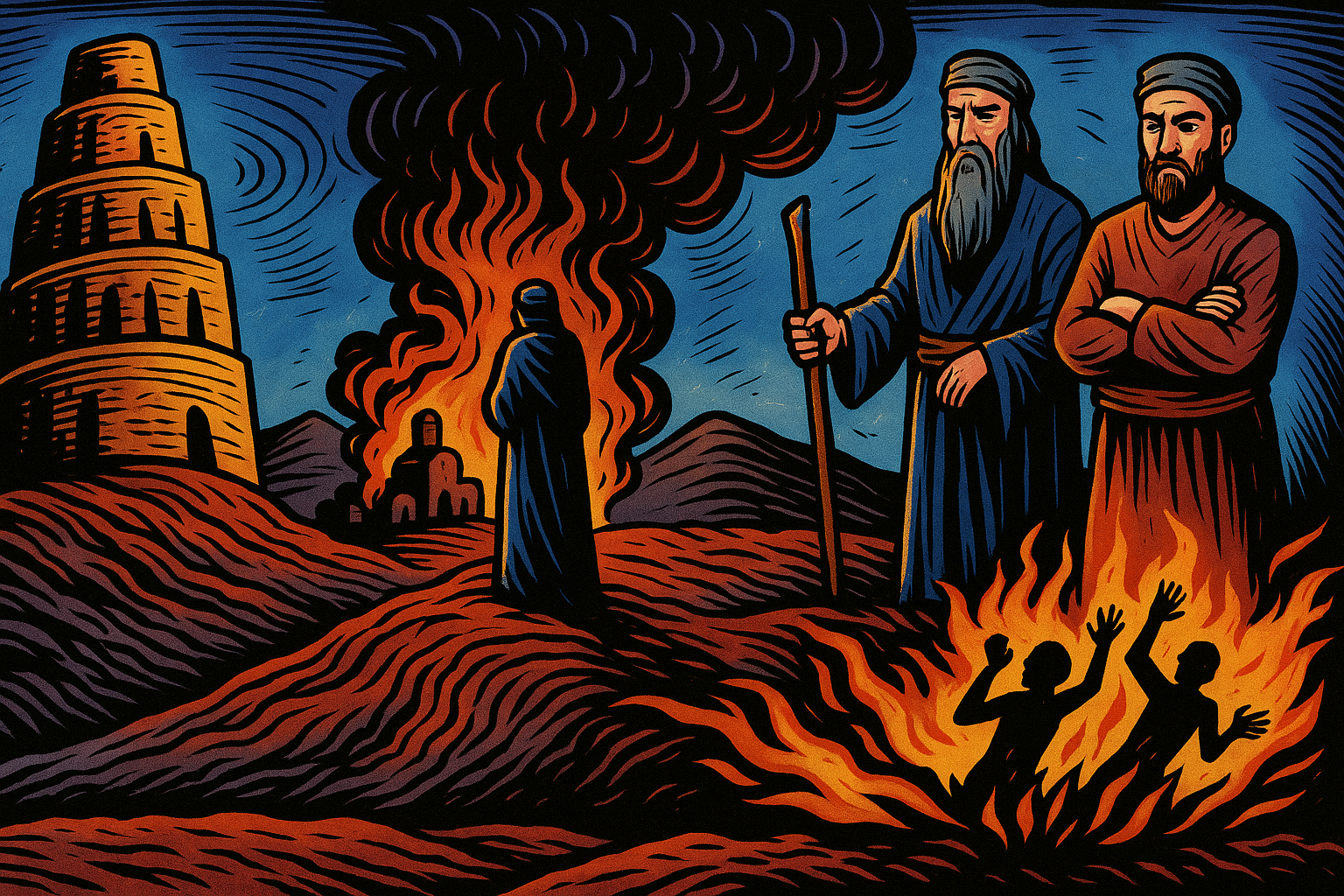The Two Hundred and Fifty Who Joined Korach

A Reincarnated Rebellion from Bavel to Korach
Long before Korach's rebellion, the Torah tells the story of several key moments when groups of people challenged the Divine order—sometimes subtly, sometimes openly. From the builders of the Tower of Bavel to the people of S'dom and the cities of the plain, these rebellions were not simply acts of defiance, but distorted spiritual aspirations that overreached their boundaries. Against this backdrop, the story of Korach emerges not in isolation, but as part of a much deeper chain of spiritual recurrence.
The Torah describes a remarkable number at the heart of one of its most dramatic uprisings (Bemidbar 16:2): וַיָּקֻמוּ לִפְנֵי מֹשֶׁה וַאֲנָשִׁים מִבְּנֵי־יִשְׂרָאֵל חֲמִשִּׁים וּמָאתָיִם נְשִׂיאֵי עֵדָה קְרִאֵי מוֹעֵד אַנְשֵׁי־שֵׁם (And they rose up in the presence of Moshe, and men from B'nei Yisrael, two hundred and fifty leaders of the congregation, summoned for meeting, men of renown). These individuals who joined Korach in his uprising, along with Datan and Aviram, were not fringe figures. They were leaders, well-known to the people. Rashi says on Bemidbar 16:1 that they were רָאשֵׁי סַנְהֶדְרָאוֹת (heads of the courts), i.e. judges—well-versed in the details of the Holy Torah.
Who were these men? Rashi actually tells us the name of one of them—Elitzur ben Shedeur from the Tribe of Reuven—but that's not what we're asking. It doesn't matter to us what their actual names were. We want to know who they really were, where they came from, and what their underlying sin was.
The mystery of who these people were begins to unravel when we notice how pointedly the Torah highlights their number—two hundred and fifty. Why exactly 250 men? And why did the Torah need to tell us that there were exactly 250 men?
A profound answer lies buried in a cryptic passage found in the Megaleh Amukot, which traces a hidden spiritual lineage connecting these 250 men to two earlier generations of rebellion: the Generation of the Dispersion [דּוֹר הַפְּלָגָה, Dor ha-Pelagah]—those who built the Tower of Bavel and were later dispersed throughout the world—and the men of S'dom [אַנְשֵׁי סְדוֹם, Anshei S'dom]. According to this teaching, the same root souls reappear across these three episodes, each time attempting to seize spiritual power without proper vessels, and each time suffering a dramatic downfall (Va'Etchanan 181): ידוע שסוד דור הפלגה נתגלגלו אחר כך והיו דורות של סדום, ואחר היו במחלוקת של קרח…וזהו הסוד ואנשי העיר, זה אנשי סדום (בראשית יט ד), ר"ל שאנשי סדום היו ממש של אנשי העיר, הם שבנו המגדול עיר וראשו בשמי (It is known that the secret of the Dor Pelagah is that they were reincarnated afterward as the generations of S'dom, and afterward, they were in the controversy of Korach…And this is the secret of 'and the men of the city, these are 'the men of S'dom' [Bereshit 19:4], that is to say, that 'the men of S'dom' were literally of 'the men of the city,' those that built the tower, a city with its top reaching to Heaven).
The Megaleh Amukot is revealing an important truth hidden in an apparently simple pasuk (Bereshit 19:4): טֶרֶם יִשְׁכָּבוּ וְאַנְשֵׁי הָעִיר אַנְשֵׁי סְדֹם נָסַבּוּ עַל־הַבַּיִת מִנַּעַר וְעַד־זָקֵן כׇּל־הָעָם מִקָּצֶה (Before they had lain down, and the men of the city, the men of S'dom, surrounded the house, from young to old, all the people from every quarter). Why does the pasuk tell us two otherwise obvious points—the people who converged on Lot's house were 'the men of the city' and they were also 'the men of S'dom.' Isn't that obvious? The pasuk could have said simply, "and they converged on the house…" We would know who 'they' were from the context of the story. The Megaleh Amukot reveals to us the secret that 'the men of S'dom' are the same people as 'the men of the city.' Which city is so central, so archetypal, that it’s simply called the city? It is the original—infamous—city, the city of Bavel (Bereshit 11:4): וַיֹּאמְרוּ הָבָה נִבְנֶה־לָּנוּ עִיר וּמִגְדָּל וְרֹאשׁוֹ בַשָּׁמַיִם וְנַעֲשֶׂה־לָּנוּ שֵׁם פֶּן־נָפוּץ עַל־פְּנֵי כׇל־הָאָרֶץ (And they said, Let us build for ourselves a city, and a tower, and its top reaching Heaven, and let us make a name for ourselves lest we be dispersed over the face of the whole earth).
Why do we even need to know this? By understanding who people are—and where they came from—we are able to stitch a thread through time, to weave together apparently disconnected bits of history and see them as a whole tapestry. And therefore, the root sin of one generation will often manifest itself in another, apparently unrelated, generation. In our case, the sin of S'dom is rooted in the sin of the Generation of the Dispersion. And what was at the root of their desire to build a city and a tower that reached to Heaven? The Midrash teaches (Bereshit Rabbah 38:7): וַיְהִי בְּנָסְעָם מִקֶּדֶם (בראשית יא, ב), נָסְעוּ מִן מַדִּינְחָא לְמֵיזַל לְמַדִּינְחָא, אָמַר רַבִּי אֶלְעָזָר בְּרַבִּי שִׁמְעוֹן הֵסִיעוּ עַצְמָן מִקַּדְמוֹנוֹ שֶׁל עוֹלָם, אָמְרוּ אִי אֶפְשֵׁינוּ לֹא בוֹ וְלֹא בֶּאֱלָקוּתוֹ ([It is written in Bereshit 11:2]: 'And it came to pass, as they traveled from the east [מִקֶּדֶם, mi'kedem].' Did they travel from the east to go to the east? R' Elazar bar R' Shimon said, They transported themselves from the Primordial One [Kadmon] of the World, and they said, It is impossible for us, not in Him and not in His godliness).
This Midrash reveals that mi'kedem is not merely geographical—it implies a spiritual regression. The Dor ha-Palagah did not just head eastward to arrive at the Plain of Shinar; they moved away from the Source of True Light and they wanted no part in Ha-Kadosh, baruch Hu. Their attempt to built a city—for their own kavod—not for the kavod of Hashem—was an existential journey to distance themselves as far as possible from Hashem and His ways. They weren't just involved in an innocent building project. Rather, it was a spiritual coup. They weren't merely trying to reach the sky in a physical sense, but rather they sought to wage war against Hashem, to breach the upper worlds and to assert dominion over Heaven itself. They knew the truth of Hashem's sovereignty. They just didn't want anything to do with it. It wasn't atheism. It was raw ambition—spirituality without submission.
The souls of S'dom were not new souls. They were the very same spiritual rebels of the Dor Pelagah, now reincarnated and embedded within an earthly civilization gone completely astray. After tolerating their injustice and depravity for years, Hashem eventually decided to destroy them. However, one man stood in His way (Bereshit 18:24-25): וַיִּגַּשׁ אַבְרָהָם וַיֹּאמַר הַאַף תִּסְפֶּה צַדִּיק עִם־רָשָׁע׃ אוּלַי יֵשׁ חֲמִשִּׁים צַדִּיקִם בְּתוֹךְ הָעִיר הַאַף תִּסְפֶּה וְלֹא־תִשָּׂא לַמָּקוֹם לְמַעַן חֲמִשִּׁים הַצַּדִּיקִם אֲשֶׁר בְּקִרְבָּהּ (And Avraham approached and he said, Will you even destroy a tzaddik with a rasha? Perhaps there are fifty tzaddikim in the midst of the city. Would you even destroy and not spare the place for the sake of the fifty tzaddikim which are within it?).
Avraham's stance is not only remarkable but exceedingly difficult to comprehend. Tzaddikim in S'dom?! What was he thinking? Did he not know the level of depravity of the city? Of course he did. He wasn't blind. What, then, was his true intention? And further, why did he say חֲמִשִּׁים הַצַּדִּיקִם, i.e. the fifty tzaddikim—that is, the use of the definite article suggests a known group. Which fifty tzaddikim?
We have now arrived at a tremendous chiddush of the Megaleh Amukot. But before we reveal it, we must understand how Rashi understands this pasuk. A simple reading of the pasuk would imply that Avraham was pleading that if Hashem would find fifty tzaddikim in S'dom that the city should be spared, right? And to solidify this understanding, Hashem affirms that Avraham meant exactly this (Bereshit 18:26): וַיֹּאמֶר יְהֹוָה אִם־אֶמְצָא בִסְדֹם חֲמִשִּׁים צַדִּיקִם בְּתוֹךְ הָעִיר וְנָשָׂאתִי לְכׇל־הַמָּקוֹם בַּעֲבוּרָם (And Hashem said, If I find fifty tzaddikim in S'dom, in the midst of the city, I will spare all the place for their sake). Before going further, notice that this pasuk uses a very similar double phraseology to what we saw earlier—'in S'dom' and 'in the midst of the city'. That, in and of itself, should give us a clue what's going on beneath the surface.
Disregarding the plain meaning of these pesukim, Rashi says something rather extraordinary on Bereshit 18:24: עֲשָׂרָה צַדִּיקִים לְכָל כְּרַךְ וּכְרַךְ, כִּי ה' מְקוֹמוֹת יֵשׁ (Ten tzaddikim per city, for there are five places). So even though these pesukim state unequivocally that Avraham and Hashem mentioned fifty tzaddikim in S'dom alone, Rashi understands that they were really talking about only ten tzaddikim in S'dom, with the other forty coming from the other four cities of the plain—ten from each city—Amorah, Admah, Tz'voyim, and Tzo'ar. And we know the story of how Avraham went down from fifty and eventually stopped at ten, ten being the minimum number of people for a minyan.
The Radak, however, hints at something much deeper, much more in line with the plain reading of the pesukim. His first explanation: אולי יש חמשים צדיקים בתוך העיר, ויש לפרש בתוך העיר בתוך סדום כמו שהיה המענה אם אמצא בסדם, ואם בסדום שהיא גדולה ימצאו חמשים צדיקים אי אפשר שלא ימצאו צדיקים גם כן בשאר הערים ('Perhaps there are fifty tzaddikim in the midst of the city'—It is possible to explain 'in the midst of the city' as 'in the midst of S'dom,' similar to how He answered, 'If I find in S'dom.' And if in S'dom which is large, they find fifty tzaddikim, is it impossible that they won't find tzaddikim also in the rest of the cities?). According to the Radak, when the pesukim mention fifty tzaddikim in S'dom, it literally means fifty tzaddikim in S'dom, the implication being that there must be even more tzaddikim when we include the other four cities.
However, the Radak's second explanation is even more to the point:או יהיה פירושו בתוך כל עיר ועיר מערי המלוכה…והמענה אם אמצא בסדום והוא הדין לכל אחת מהערים האחרות, אלא זכר סדם לפי שסדם היא אם לכלם, ולפי שהיה לוט בתוכה ידע כי לב אברהם עליה יותר מן השאר בעבור לוט (Or, the explanation could be [fifty] in each and every royal city…and [the explanation of] the answer 'If I find in S'dom' is that the same thing applies to each of the other cities, but he mentioned S'dom because S'dom was the 'mother' of them all, and because Lot was there, and He knew that Avraham's heart was toward it more than [toward] the rest [of the cities], because of Lot). So let's add them up. Fifty from S'dom plus fifty from Amorah plus fifty from Admah plus fifty from Tz'voyim plus fifty from Tzo'ar comes to a grand total of two hundred and fifty. In part, this is what is behind what we read above from the Megaleh Amukot: ידוע שסוד דור הפלגה נתגלגלו אחר כך והיו דורות של סדום, ואחר היו במחלוקת של קרח (It is known that the secret of the Dor Pelagah is that they were reincarnated afterward as the generations of S'dom, and afterward, they were in the controversy of Korach). Therefore, when Avraham negotiated down from fifty to ten, he wasn't relying on just one minyan for all five cities. He understood that he would need one minyan for each city.
Therefore, the 250 men who appear in the rebellion of Korach are these same souls, and thus their spiritual lineage should give us insight into what was at the root of their uprising. As we read earlier, they are described as נְשִׂיאֵי עֵדָה קְרִאֵי מוֹעֵד אַנְשֵׁי־שֵׁם (leaders of the congregation, summoned for meeting, men of renown). Men of renown [אַנְשֵׁי־שֵׁם]—does this wording not echo a familiar phrase? The Megaleh Amukot lays out the connection directly: ולכן אמר אנשי שם (במדבר טז ב) והם בנו המגדול נעשה לנו שם (Therefore, it said [Bereshit 16:2]: 'men of renown', and they built the tower [Bereshit 11:4]: 'let us make a name for ourselves'). It's the same souls harboring the same skewed ambitions—to be considered 'big shots,' people that others look up to and admire. These men were no ordinary rebels—they were spiritual aspirants, elite leaders, still striving to exert control over Divine authority.
In summary, what was their sin? On the surface, it appears like they desired closeness to Hashem. After all, they brought incense, a holy service that only kohanim may perform. However, we have seen that their transgression was not in the offering in and of itself, but in their assumption of spiritual authority. And yet, the sin of the 250 was not merely unauthorized spiritual ambition—it was directed rebellion against Moshe Rabbeinu, the embodiment of Divine order in this world.
What, then, is the lesson for us today? Kedushah cannot be seized; it can only be received. The structure of kedushah is not a ladder to be stormed by ambition but a pathway to be entered with awe and humility. These stories—of Bavel, of S'dom, and of Korach—are not just ancient narratives. They are spiritual diagnostics. They remind us that not all passion is holy, not all fire is pure, and not all seekers are genuine. Without submission to the true Tzaddik—without holy vessels—spiritual light can lead to spiritual destruction. True elevation comes not from reaching up, but from humbling oneself to receive from above.






